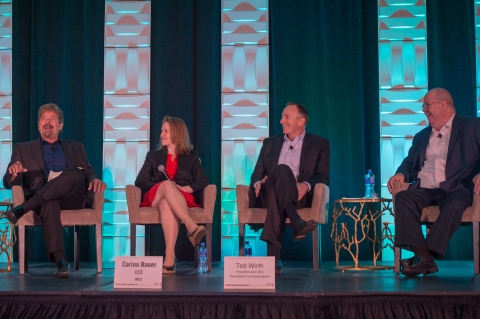Dallas Rolls Out Red Carpet for Society of Independent Show Organizers’ 200 Attendees

Two hundred attendees experienced the best that Dallas has to offer during three days of networking and education at the Society of Independent Show Organizers’ 2015 SISO Leadership Conference, held Aug. 3-5.
“Dallas as a destination should be considered by anyone in the industry,” said Lew Shomer, SISO’s executive director.
He added, “We put a program together to encourage young professionals to become leaders. The content was directed toward them, and we achieved that goal.”
The opening night party kicked off with attendees heading over to the world-famous Gilley’s, where they donned Stetson’s, did some bull riding and listened to, what else, but a country music band.
The next morning, the conference officially opened with Hugh Forrest, who heads the SXSW Interactive Festival, detailing how the event, which is part of the SXSW in Austin every March, grew from its inception in 1987 to currently 70,000 attendees with a $315 million economic impact to the city.
“The best way to describe (SXSW) is it’s sensory overload,” Forrest said, adding that creating, building and engaging the community was the secret to the event’s success.
“You have to pay attention to community,” Forrest said. “”I am a huge believer in the power of community. Communication is always the key to increasing your community.”
Even with a lot of talk about social media and people meeting up online, he added that “there still is nothing as effective as meeting face-to-face.”
The next two sessions focused on Millennials, who as a group will surpass Gen-Xers and Baby Boomers as the dominant demographic in the workplace in the coming years.
Brian Casey, CEO and president of the Center for Exhibition Industry Research, discussed two studies that took a look at how Millennials want to be engaged at a show.
Some key findings included they like still like e-mail, hands-on education is important to them, such as facilitated, bit-sized sessions, and, Casey added, “They will push exhibitors for more engagement.”
A panel was next up with two professionals who not only are Millennials, but they both also help business and financial coach their peers.
Amber Aziza, Millennial biz coach, ASquared Coach, said, “With social media, sometimes it’s about the long game getting (Millebnnials) to come to an event.”
Katie, financial coach, Your Richest Life, added that Millennials have grown up with technology and they “want it to work.” She advised that show organizers do a thorough run through with all technology before putting it in front of Millennials.
Other sessions for the day included “Building attendance in a digitally focused world”, with Kevin Ryan, CEO of Motivity Marketing, also encouraging show organizers to find ways to engage with people that makes them feel connected.
Greg Topalian, president of Leftfield Media, advised show organizers to find people online who are driving action. “Go get the influencers who are actually out there” to help spread the word, he added.
The first day’s final panel focused on how contractors and show organizers can work together “to create great events, improve the customer experience and save money.”
Albert Chew, president of expositions for Freeman, said he definitely saw change coming, adding that everyone could either work together on it or get dragged through it.
Tony Calanca, executive vice president of Exhibitions for UBM Advanstar, said, “Do you want to know how good your show was? Stand by the service desk the day after bills go out (to exhibitors). Are they happy?”
The night’s activities included dining on three levels of the Perot Museum of Nature and Science surrounded by huge dinosaur skeletons, multi-colored gemstones and interactive exhibits.
The final morning’s education began with the 3rd Annual SISO Event Innovation Battlefield, in which four event technology companies slugged it out for the top spot.
It was a really tight race, but feathr, an event marketing cloud providing a comprehensive and synergistic set of marketing and analytics tools designed specifically for the events industry, ended up grabbing the top prize after attendees in the room completed the real-time voting process.
Next up was “Climbing the ladder - CEO Panel, how did they get there? How do they select their Successor?”, with three CEOs and moderator Don Pazour, CEO of Access Intelligence.
“I never expected to be the CEO” said Ted Wirth from Diversified Communications. He was asked to step in after Nancy Hasselback announced she was retiring. “I actually thought I was getting fired,” he joked.
Carina Bauer from IMEX Group worked with her father Ray Bloom at the company running one of the divisions when she was asked to take the lead role. “I wasn’t parachuted in as the owner’s daughter,” she added.
Rick McConnell of Informa said he was asked to be interim president when two other executives left the company. “I said, ‘Why does it have to be interim?’”
All of the leaders agreed that treating employee’s well was the key to their company’s success. “People are drawn to others who are authentic and genuine,” McConnell said.
The last two panels of the day included building international attendance, in which Denise Capello, director, Business Acquisition, Amsterdam RAI Convention Centre, said that the challenge with Europe was it’s very diverse. “Who are you really targeting?,” she asked.
And in the final panel, successful sponsorship packages were discussed. “I’m not a fan of one- size-fits-all,” said Brian Pagel, vice president, Kitchen and Bath Group, Emerald Expositions. “Then it becomes just a transactional relationship. We want to help them achieve their goals.”


Add new comment